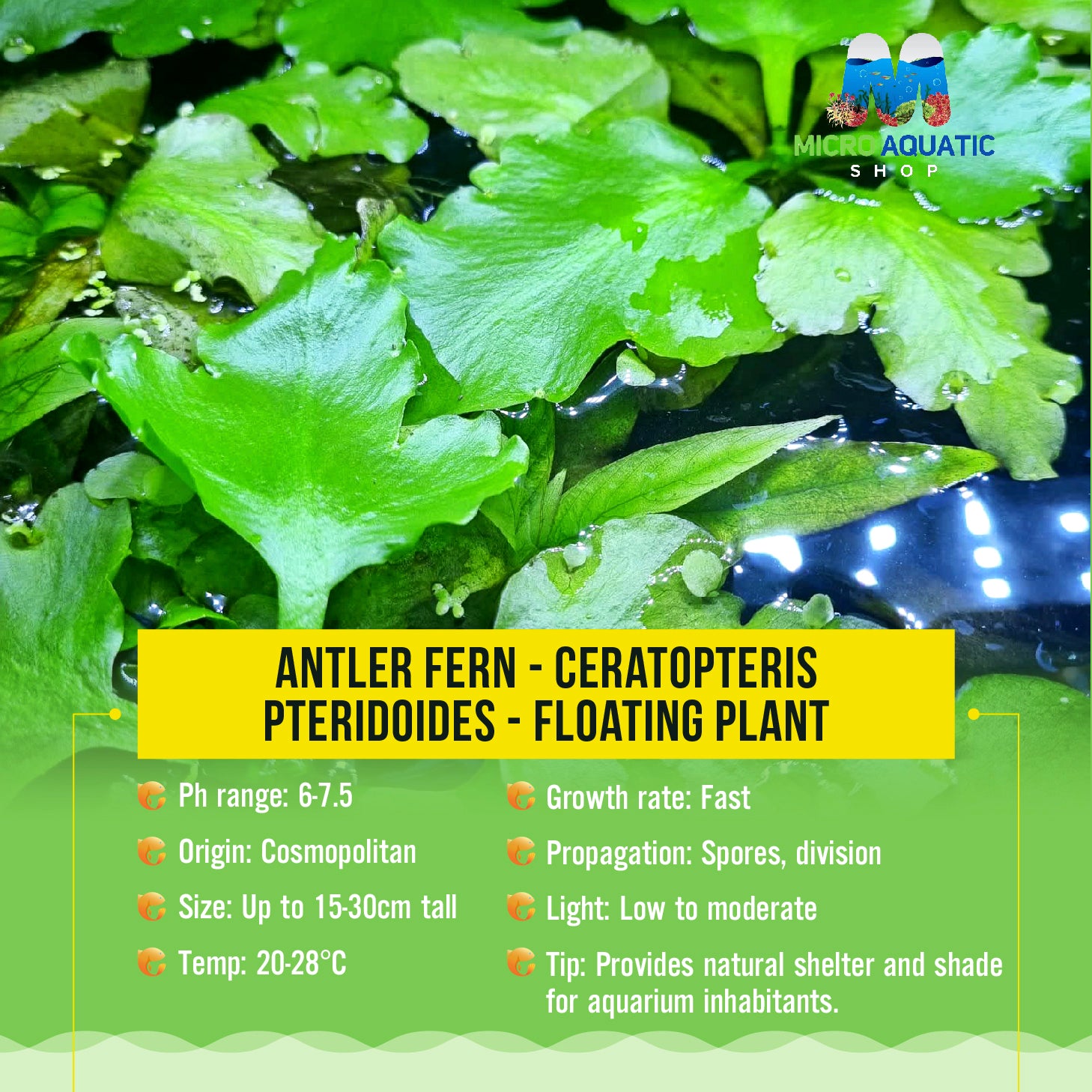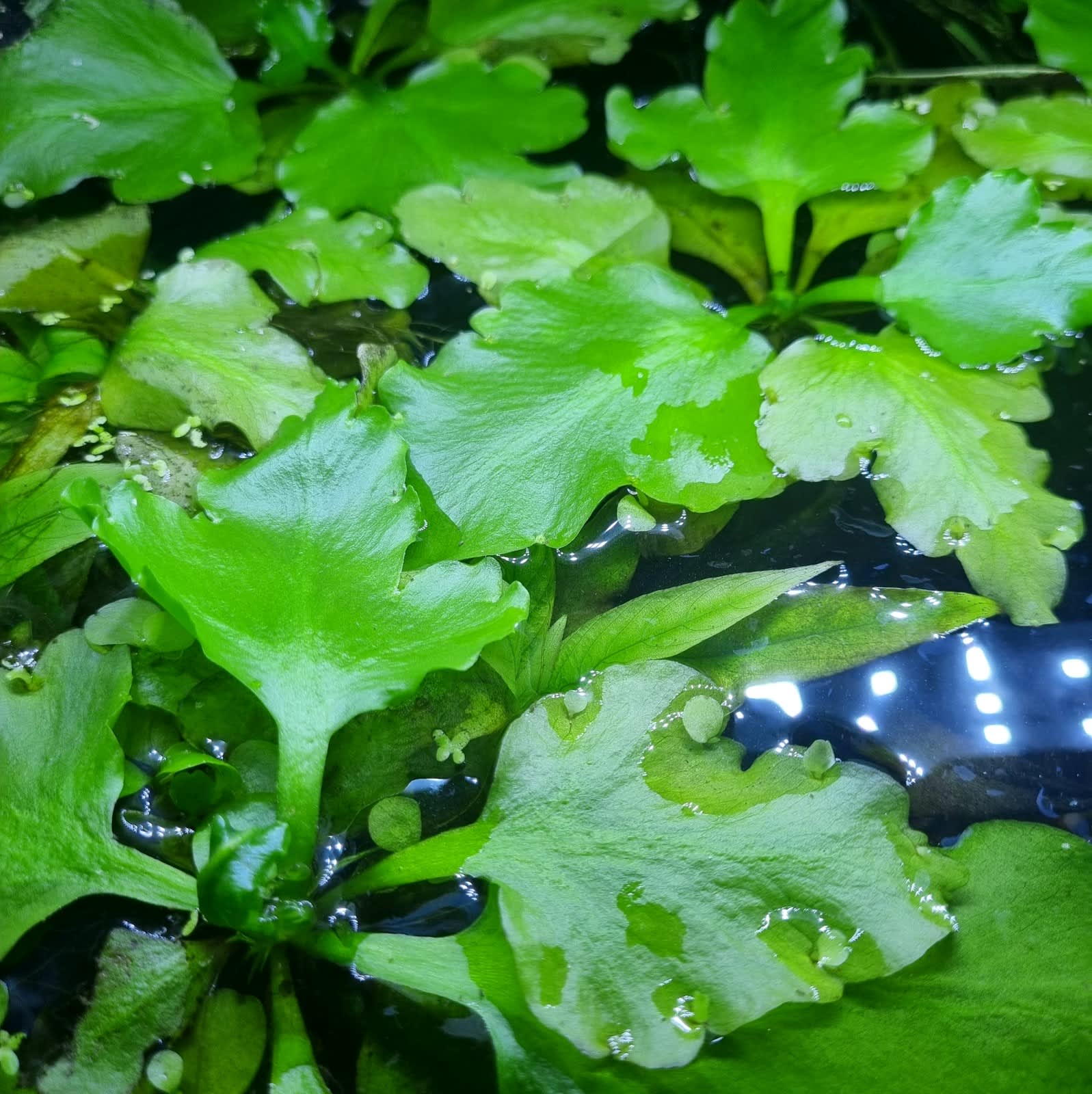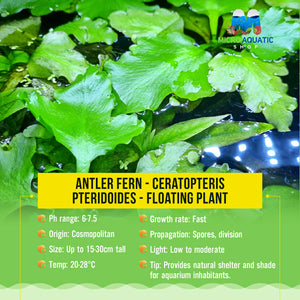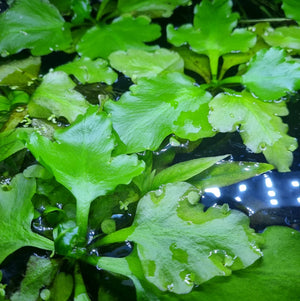Antler fern - Ceratopteris pteridoides -Floating Plant
Guarantee Safe Checkout
Ceratopteris pteridoides (Antler Fern) - Unique Floating Aquarium Plant
We're always searching for amazing aquatic plants for our aquariums. The Ceratopteris pteridoides, or Antler Fern, is a standout. It's loved by many in Australia for its unique look.  The Antler Fern's fronds look like antlers, making it a stunning addition to any tank. It comes from tropical areas and loves the calm water of our tanks. At Micro Aquatic Shop, we're proud to sell this plant. We help our customers turn their tanks into lush, underwater worlds.
The Antler Fern's fronds look like antlers, making it a stunning addition to any tank. It comes from tropical areas and loves the calm water of our tanks. At Micro Aquatic Shop, we're proud to sell this plant. We help our customers turn their tanks into lush, underwater worlds.
Key Takeaways
- Ceratopteris pteridoides, or Antler Fern, is a captivating floating aquarium plant
- Originates from tropical regions, thriving in the still waters of aquariums
- Adds a touch of natural beauty with its intricate, antler-like fronds
- Available at Micro Aquatic Shop, a trusted source for aquarists in Australia
- Versatile plant that can elevate the aesthetics of any underwater aquascape
Understanding the Enchanting Antler Fern: An Overview
The Antler Fern, known as Ceratopteris pteridoides, is a semi-aquatic plant loved by many. It's an Australian native plant that adds beauty to any freshwater aquarium. This ornamental aquarium plant thrives in water, making it a standout choice.
Natural Habitat and Distribution
The Antler Fern comes from Australia's tropical and subtropical areas. It loves marshes, swamps, and slow-moving waters. Its ability to adapt to different waters makes it popular among aquarium fans.
Distinctive Features and Growth Patterns
The Antler Fern's fronds look like antlers and float on the water. These leaves are not just pretty; they also help with oxygen and filtering. They make the aquarium look better and keep the water healthy. This fern grows fast and can cover the water's surface. It's perfect for those who want a lush, green look in their aquarium.
Why Choose Antler Fern for Your Aquarium
The Antler Fern is more than just pretty. It's a semi-aquatic plant that keeps the water clean. Its fronds also give fish and invertebrates places to hide. Plus, it's easy to care for, making it great for all aquarium owners. "The Antler Fern's unique charm and functional advantages make it a must-have for any aquarium enthusiast seeking to create a visually stunning and ecologically balanced underwater landscape."
Ceratopteris pteridoides , Antler fern: Essential Care Requirements
The Antler Fern, or Ceratopteris pteridoides, is a special rhizome plant and epiphytic fern. It needs special care to grow well in our aquariums. Let's explore what it needs to thrive.
Nutrient and Water Conditions
The Antler Fern loves nutrient-rich water. Use a liquid fertiliser or nutrient-rich substrate to feed it. It prefers water with a pH between 6.0 and 7.5 and a temperature of 22-28°C.
Lighting and Placement
This fern needs moderate to high light to stay green. Place it in the middle to upper parts of the aquarium. Avoid too much direct light to prevent discoloration or slow growth.
Growth and Maintenance
The Antler Fern grows fast, so it needs regular trimming. Remove dead or damaged fronds to promote new growth. Also, watch out for floating plantlets that can be used to grow more ferns.
| Care Requirement | Optimal Conditions |
| pH | 6.0 - 7.5 |
| Temperature | 22°C - 28°C |
| Lighting | Moderate to high |
| Nutrients | Comprehensive liquid fertiliser or nutrient-rich substrate |
| Maintenance | Regular pruning and removal of dead/damaged fronds |
By meeting the Antler Fern's unique needs, we can make a vibrant aquatic space. This showcases the beauty of this rhizome plant and epiphytic fern.
Creating the Perfect Environment for Your Floating Fern
To grow an aquatic fern like the Ceratopteris pteridoides, you need to focus on the right conditions in your aquarium. This includes the water quality and the light it gets. Let's explore what's needed for your fern to flourish.
Water Parameters and Quality
The antler fern gets all it needs from the water in your tank. For it to grow well, keep the water parameters as follows:
- pH range: 6.0 to 7.5
- Temperature: 20°C to 28°C
- Hardness: Soft to moderately hard (2-15 dGH)
- Dissolved Oxygen: Make sure the water is well-oxygenated
Changing the water regularly and using safe dechlorinators is key. Also, watch for any changes in these water values to keep your fern healthy.
Lighting Requirements
The antler fern does best with moderate to bright light. You'll want to aim for 2-4 watts per gallon. This ensures it gets enough light without getting stressed from too much.
Temperature and pH Considerations
The ideal temperature for the antler fern is between 20°C and 28°C. Keeping the temperature steady is important for its health. Also, the best pH is between 6.0 and 7.5. You can use special substrates and buffers to keep the pH right.
| Parameter | Ideal Range |
| pH | 6.0 to 7.5 |
| Temperature | 20°C to 28°C |
| Hardness | Soft to moderately hard (2-15 dGH) |
| Dissolved Oxygen | Adequate aeration |
| Lighting Intensity | 2-4 watts per gallon (50-100 lumens per litre) |
By keeping these conditions perfect, you'll give your aquatic fern the best chance to thrive. It will grow beautifully and add a special touch to your tank.
Propagation Methods and Growth Management
As an avid aquarium enthusiast, we know the joy of growing an underwater garden. The Ceratopteris pteridoides, or antler fern, is a great addition. We've got tips on how to grow and propagate this unique plant.
Propagating the Antler Fern
Propagating the Ceratopteris pteridoides is easy. You can divide the plant, separating the rhizome into smaller parts. Make sure each part has a frond and roots. Then, plant these divisions in your aquarium for new plants.  You can also collect spores and sow them on damp substrate. With the right conditions, these spores will grow into new Ceratopteris pteridoides plants. This way, you can expand your collection.
You can also collect spores and sow them on damp substrate. With the right conditions, these spores will grow into new Ceratopteris pteridoides plants. This way, you can expand your collection.
Controlling and Maintaining Growth
To keep your Ceratopteris pteridoides healthy, manage its growth. Trim the fronds regularly. This keeps the plant in shape and prevents it from blocking water flow and light in your aquarium.
| Propagation Method | Advantages | Considerations |
| Division |
|
|
| Spore Propagation |
|
|
By using these methods and techniques, you can grow a healthy Ceratopteris pteridoides in your aquarium. It will add beauty and interest to your underwater garden.
Common Challenges and Troubleshooting Tips
Growing the enchanting aquatic fern, Ceratopteris pteridoides, or the Antler Fern, is rewarding for many in Australia. Yet, it faces common challenges. Let's look at these issues and how to fix them to help your Antler Fern thrive.
Identifying and Treating Common Issues
Yellowing or discoloured leaves are common problems with Antler Fern. This can be due to bad lighting, not enough nutrients, or poor water quality. Check your aquarium's lighting, fertilisation, and water quality. Make changes as needed. Slow growth or stunted development is another issue. It might be from not enough nutrients, poor water flow, or wrong water temperature. Try different fertilisers, improve water flow, and keep the water at the right temperature.
Preventive Maintenance Strategies
To avoid problems with your Antler Fern, follow a regular maintenance routine. Do frequent water changes, check and adjust water parameters, and ensure enough nutrients. Also, trim and prune the fern to promote healthy growth and prevent overcrowding.
Recovery Techniques
If your Antler Fern is struggling, don't give up! You can often help it recover. First, check for diseases or pests and fix any problems. Increase water changes, add CO2, or move it to better lighting and water flow. Understanding common challenges and using effective solutions can keep your Antler Fern thriving. With patience and some trial and error, you can enjoy its beauty for years.
Companion Plants and Aquascaping Ideas
Adding the floating fern, Ceratopteris pteridoides, to your aquarium can change the game. This Australian native plant brings natural beauty and pairs well with many aquatic species. Here are some ideas to make your aquarium stand out. The Amazon sword plant (Echinodorus spp.) is a great match for the antler fern. These plants offer a sturdy base and a delicate contrast. The sword plant's broad leaves and the fern's lacy fronds create a beautiful balance. For a splash of color, pair the floating fern with Rotala's vibrant red or green varieties. These plants grow fast and add bright hues. The antler fern softens the look, making it more appealing.
| Companion Plant | Characteristics | Complementary Traits |
| Amazon Sword (Echinodorus spp.) | Robust, rosette-forming plant | Provides grounded contrast to floating fern |
| Rotala (various species) | Vibrant red or green stem plants | Adds colorful accents to the floating fern |
| Water Sprite (Ceratopteris thalictroides) | Delicate, lacy aquatic fern | Creates a harmonious pairing with the antler fern |
Use the antler fern as a focal point for a stunning aquascape. Let its fronds cascade and surround it with carpeting plants. Dwarf Hairgrass or Marsilea minuta works well. The floating fern contrasts beautifully with these plants, adding depth and interest. The Ceratopteris pteridoides, or antler fern, is essential for a stunning aquarium. It's versatile and adds charm. By choosing the right companion plants and using the fern's floating habit, you can create an amazing underwater garden.
Conclusion
The Ceratopteris pteridoides, or Antler Fern, is a standout in floating aquarium plants. It adds natural elegance to any underwater space. Its unique growth and care needs make it a favorite among aquarium lovers in Australia. Knowing what the Antler Fern needs helps it thrive in our tanks. It's perfect for both experienced aquascapers and beginners. Adding it to your aquarium creates a stunning and balanced underwater world. For top-notch Ceratopteris pteridoides, check out Micro Aquatic Shop. They offer a wide range of aquatic plants and essentials. Their expertise ensures you get healthy, beautiful Antler Ferns to enjoy for years.
Knowing what the Antler Fern needs helps it thrive in our tanks. It's perfect for both experienced aquascapers and beginners. Adding it to your aquarium creates a stunning and balanced underwater world. For top-notch Ceratopteris pteridoides, check out Micro Aquatic Shop. They offer a wide range of aquatic plants and essentials. Their expertise ensures you get healthy, beautiful Antler Ferns to enjoy for years.
FAQ
What is Ceratopteris pteridoides, also known as the Antler Fern?
Ceratopteris pteridoides, or the Antler Fern, is a unique aquatic fern. It's popular among aquarists for its floating growth habit. This makes it a great choice for aquariums.
Where does the Antler Fern naturally occur?
The Antler Fern is found in Australia's freshwater habitats. This includes streams, ponds, and wetlands. It thrives in both water and on land.
What are the distinctive features of the Antler Fern?
The Antler Fern has striking, antler-like fronds. Its rhizome-based growth allows it to float on water. It can grow both submerged and emersed, making it versatile.
Why is the Antler Fern a popular choice for aquariums?
The Antler Fern is loved for its unique look and easy care. It's a floating fern that adds beauty and helps with water quality. It provides oxygen and filtration.
What are the essential care requirements for the Antler Fern?
The Antler Fern is easy to care for but needs specific conditions. It prefers nutrient-rich water, moderate light, and a slightly acidic pH. It can be anchored or float freely.
How can I create the perfect environment for my Antler Fern?
For your Antler Fern, manage water, light, and temperature well. Aim for moderate to high light, a pH of 6.0 to 7.0, and a temperature of 20-25°C. Good water quality and nutrients are key for its health.
How can I propagate and manage the growth of the Antler Fern?
You can propagate the Antler Fern by dividing the rhizome or letting it spread naturally. Regular trimming helps keep it looking good and prevents overgrowth. With care, your fern will thrive.
What are some common challenges when growing the Antler Fern, and how can I troubleshoot them?
Yellowing fronds, slow growth, and algae are common issues. Adjust water parameters, ensure enough light, and provide the right nutrients. With some troubleshooting, your fern will be healthy again.
What companion plants work well with the Antler Fern, and how can I incorporate it into my aquascaping?
The Antler Fern looks great with floating plants like Salvinia or Duckweed. It also pairs well with submerged plants like Cryptocoryne or Anubias. Use it as a focal point or anchor it to create a natural look.
| Quantity |
1 plant 3 cm |
|---|




